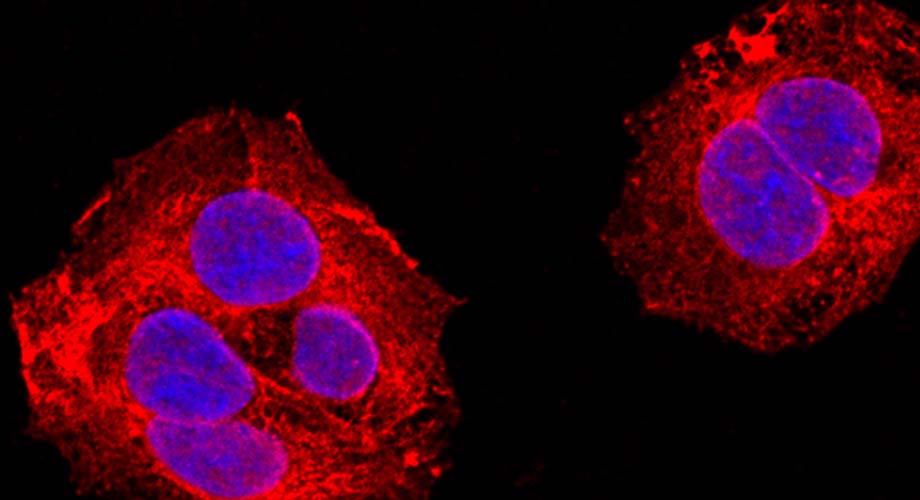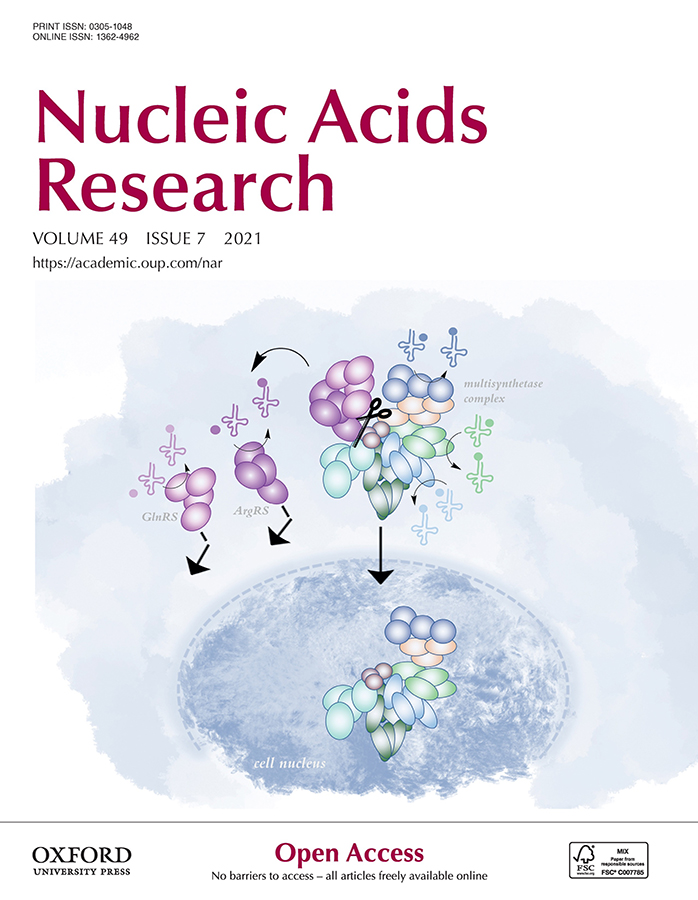
Enzymes called aminoacyl tRNA synthetases, or aaRSs, set off the first step of translating genetic code into a protein. A new study looks at why these enzymes are typically found in small groups, or "complexes." Image: Localization of an aaRS (in red) in a human cell. Courtesy of Haissi Cui, PhD, of the Schimmel laboratory.
Why do protein-making enzymes cluster together? Not for the reason many think
Breakthrough research provides a deeper understanding of enzymes that shape many facets of health.
April 30, 2021

LA JOLLA, CA—Through intricate experiments that hold broad impact across many disease areas, Scripps Research scientists have revealed why certain enzymes that are best known for helping create proteins are often clustered together in groups of nine.
The study is featured on the cover of Nucleic Acids Research and is designated a “breakthrough article” by the scientific journal, as it sheds new light on an essential biological process that’s existed throughout evolution, starting with the earliest life forms.
The researchers found that the location of the clusters may play a key role in dictating new jobs that certain enzymes take on when they’re ejected from the group. This is important because some of those enzymes, when mutated, can cause disease; understanding the process may offer new paths for treatment.
“Much like tennis balls collected in a bucket, these enzymes are often joined together in a complex,” says Paul Schimmel, PhD, professor in the Department of Molecular Medicine at Scripps Research, and senior author of the study. “But every once in a while, an enzyme might be shot out of the complex and take on a completely new and unexpected purpose, just like a tennis ball being taken from the bucket to serve as a dog toy or a floor protector.”
An old theory is proved wrong
The enzymes—known as aminoacyl tRNA synthetases, or aaRSs—are often found in a cell’s cytoplasm but can be located elsewhere. Twenty different types exist, each with the primary function of linking transfer RNA (tRNA) to a specific amino acid as the first step in translating the genetic code into a protein. The resulting proteins form the basis of blood, skin, bone and a host of other essential materials. Without aaRSs, life wouldn’t be possible.
The scientific community has long hypothesized that aaRS enzymes cluster together as a way to perform their protein-making activities more efficiently. However, few scientists have been able to test that theory due to the challenges involved in probing such miniscule and complex biological machinery. Schimmel’s lab rose to the challenge, led by postdoctoral associate Haissi Cui, Ph.D.
Findings with universal impact
Using CRISPR gene editing technology, the team removed enzymes from the complex to see what would happen. To their surprise, they found the long-running hypothesis was not correct: whether the enzymes were grouped together or separated on their own, they were just as efficient at protein synthesis.
“We expected to see a change, but nothing really happened,” Cui says. “It was hard to solve for a while. Then we saw that the enzymes missing from the complex were now unable to move to another location in the cell.”
So, what’s the benefit of being grouped in a complex? Cui says one likely possibility is that the complex helps ensure that mutant enzymes don’t get loose, where they could wreak havoc on other bodily processes. The complex also allows controlled release of individual aaRS enzymes for other functions that are beneficial to health.
However, sometimes dysfunctional aaRS enzymes do escape and contribute to disease, such as cancers, lung diseases and nervous system disorders. Other experiments showed this could be influenced by their release from the complex. This can be caused by mutations and protein modifications.
“This is such a universal piece of biology,” Schimmel says. “Solving this mystery is just the beginning. We see this as an extremely promising new direction for medicine.”
The study, “Regulation of ex-translational activities is the primary function of the multi-tRNA synthetase complex,” is authored by Haissi Cui, Mridu Kapur, Jolene Diedrich, John R Yates, III, Susan Ackerman and Paul Schimmel.
The research was supported by National Foundation for Cancer Research, National Institutes of Health/ National Institute of General Medical Sciences, the German Research Foundation and the Human Frontier Science Program.
For more information, contact press@scripps.edu

